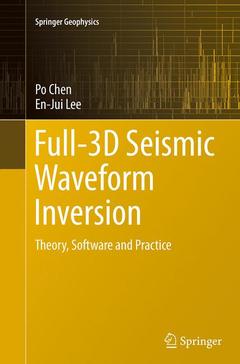Full-3D Seismic Waveform Inversion, 1st ed. 2015 Theory, Software and Practice Springer Geophysics Series
Auteurs : Chen Po, Lee En-Jui

This book introduces a methodology for solving the seismic inverse problem using purely numerical solutions built on 3D wave equations and which is free of the approximations or simplifications that are common in classical seismic inversion methodologies and therefore applicable to arbitrary 3D geological media and seismic source models. Source codes provided allow readers to experiment with the calculations demonstrated and also explore their own applications.
Preface.- Introduction.- Advantages of the seismic ray method.- Drawbacks of the seismic ray method.- Numerical solutions of the seismic wave equation.- A brief history of HPC technology.- Anelastic Wave Propagation (AWP).- Formulation.- Elastic Media.- Viscoelastic Media.- The complex modulus and its approximation.- Physical interpretation of the approximate modulus.- Isotropic viscoelastic media.- Frequency-independent Q.- Discretization.- Free-Surface Boundary.- PML Boundary.- Internal Welded Material Interfaces.- Source Representation.- Software.- Mesh Generation.- Structural Model.- Parameter File.- Sources and Receivers.- File Format.- File Processing.- Recording Grid Points.- Wavefield Simulation.- Synthetic Seismograms.- Half-Space Example Summary.- Application.- SCEC Community Velocity Models (CVMs).- Earthquake Source Models.- Validation of SCEC CVMs.- Green's Functions.- Mathematical Preliminary.- Vector Spaces.- Inner Product.- Linear Transformations.- Hilbert Spaces.- Functions As Vectors.- Dirac Delta Function.- Fourier Transforms.- Operator Algebra.- Fréchet Derivative.- The Adjoint of a Differential Operator.- Ordinary Differential Operators.- Partial Differential Operators.- Scalar Wave Equations.- Gradient, Divergence and Curl.- Viscoelastic Equation of Motion.- Adjoint Initial and Boundary Conditions.- ODE.- Scalar Wave Equations.- Anisotropic Viscoelastic Wave Equation.- Properties of Green's Functions.- Adjoint Green's Functions.- Reciprocity.- Scalar Wave-Equation Operator.- Anisotropic Viscoelastic Wave-Equation Operator.- Inhomogeneous Initial/Boundary Conditions.- General 2nd-Order ODE.- Representation Theorem.- Adjoint Representation Theorem.- Receiver Green Tensor (RGT).- Time-Reversed Adjoint Green's Tensor.- Receiver-Side Strain Green's Tensor (RSGT).- RSGTs in the Half-Space Example.- Born Series.- The Scalar Wave Equation.- Born Kernel.- Born Approximation.- The Anisotropic Viscoelastic Wave Equation.- Data Sensitivity Kernels.- Definition.- Data Functionals.- Data Functionals for u and u.- Filtered RGT.- The Chain Rule.- Time-Domain Waveform Differences.- Frequency-Domain Waveform Differences.- Broadband Cross-Correlation Measurements.- Frequency-Dependent Phase and Amplitude Misfits.- Rytov Approximation.- “Banana-Doughnut” Structure of Rytov Phase Kernels.- Model Parameterization.- Bulk Modulus.- Bulk and Shear Moduli.- Lamé Parameters.- P- and S-wave Velocities.- Love's Elastic Parameters (Hexagonal Symmetry).- Asymptotic Parameters (Triclinic Symmetry).- Anelastic Attenuation Quality Factors.- Finite Moment Tensor (FMT).- Software.- WPK File.- Kernel Calculation.- Kernel Output and Visualization.- More Examples.- S-Wave From a Double-Couple Source.- Rayleigh Wave From a Vertical Body-Force.- Head Waves.- Optimization Algorithms.- The Scattering-Integral (SI) Method.- The Gauss-Newton Algorithm.- F3DT-SI.- Scalable Parallel LSQR (SPLSQR).- Model Covariance.- Annihilator Matrix.- The Adjoint-Wavefield (AW) Method.- The Gradient.- F3DT-AW.- Hessian-Vector Product.- Software.- Adjoint Source Field.- Adjoint Wavefield.- Event Kernel.- CVM-S4.26.- Background.- Convergence Rate.- Data Functionals.- Model Evaluation.- Model Description.- CVM-S4.26 and CVM-S4 Comparison.- CVM-S4.26 and CVM-H11.9 Comparison.- Starting Model Differences.- Data Differences.- Algorithmic Differences.- Earthquake Source Parameter Differences.- Summary.- Southern Walker Lane Belt.- Long Valley Caldera.- Indian Wells Valley - Coso Geothermal Area.- Owens Lake.- Panamint Range.- Southern Sierra Nevada.- SNB Mafic Cumulates.- Tehachapi Anomaly.- Southern San Joaquin Basin.- Basin Geometry.- Great Valley Ophiolite.- Southern Coast Ranges.- Salinian Block.- Nacimiento Block.- Transverse Ranges.- Ventura Basin _ Santa Barbara Channel.- San Bernardino Basin.- Inner Continental Borderland.- Los Angeles Basin.- Offshore Region.- Mojave Desert Region.- Antelope Valley.- POR Schist.- Peninsular Ranges - Salton Trough Region.- Index.
Po Chen is an Associate Professor in the Department of Geology and Geophysics and the School of Energy Resources, University of Wyoming. He has published 24 peer-reviewed journal papers, 5 peer-reviewed conference papers, one book and three book chapters. Most of his publications are focused on different aspects of the newly emerging Full-3D Waveform Inversion (F3DWI) technique and its applications in earthquake hazard analysis/mitigation, resource exploration, crustal and upper-mantle dynamics. He teaches seismological inverse problems and has developed a set of parallel software tools for solving F3DWI problems.
En-jui Lee is currently an Assistant Professor at the Department of Earth Sciences, National Cheng Kung University, Taiwan. He has published six peer-reviewed journal papers and one book chapter on full-3D waveform inversion, including full-wave earthquake source inversions, waveform analysis tools for full-3D waveform inversions, optimized LSQR algorithm for large seismic tomographic inversions and potential applications of full-wave methods on seismic hazard analysis.
Connects FWI and conventional tomography with imaging techniques used in seismic inversions and in other scientific/engineering disciplines such as medical imaging, remote sensing, etc.
Explains the mathematics needed to fully understand FWI theory
Develops the FWI theory based on nonlinear optimization and on the data assimilation approach that has been widely adopted in atmospheric and ocean sciences
Provides a set of computer programs allowing readers to carry out the calculations demonstrated in the book and explore their own applications by modifying the source codes
Suggests applications for FWI in seismic tomography and in seismic source parameter inversions
Includes supplementary material: sn.pub/extras
Date de parution : 10-2016
Ouvrage de 513 p.
15.5x23.5 cm
Date de parution : 09-2015
Ouvrage de 513 p.
15.5x23.5 cm
